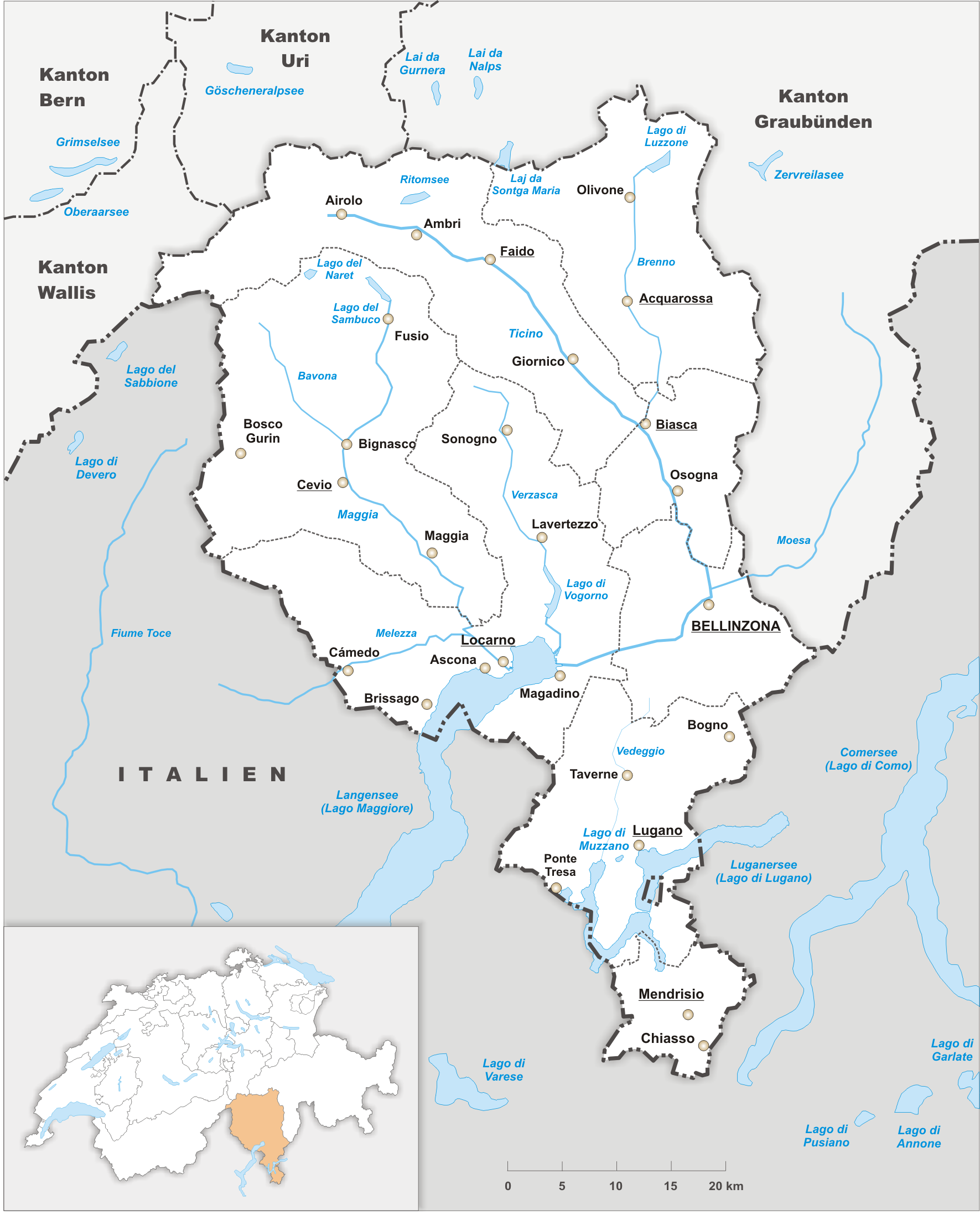|
Val Bavona
The Val Bavona is a ten-kilometer-long trough valley in the northwestern part of Ticino, Switzerland, in the Vallemaggia District. History, economy and culture First human settlements have appeared about 1000 A.D., with a constant number of people living in Val Bavona until about 1600. Repeated natural disasters caused by deforestation have then forced the population back to the lower villages of Cavergno and Bignasco, so that the numerous hamlets of Val Bavona were only used as summer abodes for farmers and livestock keepers. The prevalent economy of this valley was livestock (goats and cattle), as well as rye farming and logging. During the construction of hydro power plants, the valley received its first and only made-up road in 1957. Before that, people had to use the mule tracks between the settlements. In 1983, the valley received federal protection status. The late construction of the road, and the fact that the valley is still not attached to the electricity grid, h ... [...More Info...] [...Related Items...] OR: [Wikipedia] [Google] [Baidu] |
Val Bavona Roseto
Val may refer to: Val-a Film * Val (film), ''Val'' (film), an American documentary about Val Kilmer, directed by Leo Scott and Ting Poo Military equipment * Aichi D3A, a Japanese World War II dive bomber codenamed "Val" by the Allies * AS Val, a Soviet assault rifle Music *''Val'', album by Val Doonican *VAL (band), Belarusian pop duo People * Val (given name), a unisex given name * Rafael Merry del Val (1865–1930), Spanish Catholic cardinal * Val (sculptor) (1967–2016), French sculptor * Val (footballer, born 1983), Lucivaldo Lázaro de Abreu, Brazilian football midfielder * Val (footballer, born 1997), Valdemir de Oliveira Soares, Brazilian football defensive midfielder Places * Val (Rychnov nad Kněžnou District), a village and municipality in the Czech Republic * Val (Tábor District), a village and municipality in the Czech Republic * Vál, a village in Hungary * Val, Iran, a village in Kurdistan Province, Iran * Val, Italy, a ''frazione'' in Cortina d'Ampezz ... [...More Info...] [...Related Items...] OR: [Wikipedia] [Google] [Baidu] |
Trough Valley
U-shaped valleys, also called trough valleys or glacial troughs, are formed by the process of glaciation. They are characteristic of mountain glaciation in particular. They have a characteristic U shape in cross-section, with steep, straight sides and a flat or rounded bottom (by contrast, valleys carved by rivers tend to be V-shaped in cross-section). Glaciated valleys are formed when a glacier travels across and down a slope, carving the valley by the action of scouring. When the ice recedes or thaws, the valley remains, often littered with small boulders that were transported within the ice, called glacial till or glacial erratic. Examples of U-shaped valleys are found in mountainous regions throughout the world including the Andes, Alps, Caucasus Mountains, Himalaya, Rocky Mountains, New Zealand and the Scandinavian Mountains. They are found also in other major European mountains including the Carpathian Mountains, the Pyrenees, the Rila and Pirin mountains in Bulgaria, an ... [...More Info...] [...Related Items...] OR: [Wikipedia] [Google] [Baidu] |
Ticino
Ticino (), sometimes Tessin (), officially the Republic and Canton of Ticino or less formally the Canton of Ticino,, informally ''Canton Ticino'' ; lmo, Canton Tesin ; german: Kanton Tessin ; french: Canton du Tessin ; rm, Chantun dal Tessin . is one of the 26 cantons forming the Swiss Confederation. It is composed of eight districts and its capital city is Bellinzona. It is also traditionally divided into the Sopraceneri and the Sottoceneri, respectively north and south of Monte Ceneri. Red and blue are the colours of its flag. Ticino is the southernmost canton of Switzerland. It is one of the three large southern Alpine cantons, along with Valais and the Grisons. However, unlike all other cantons, it lies almost entirely south of the Alps, and has no natural access to the Swiss Plateau. Through the main crest of the Gotthard and adjacent mountain ranges, it borders the canton of Valais to the northwest, the canton of Uri to the north and the canton of Grisons to th ... [...More Info...] [...Related Items...] OR: [Wikipedia] [Google] [Baidu] |
Switzerland
; rm, citad federala, links=no). Swiss law does not designate a ''capital'' as such, but the federal parliament and government are installed in Bern, while other federal institutions, such as the federal courts, are in other cities (Bellinzona, Lausanne, Lucerne, Neuchâtel, St. Gallen a.o.). , coordinates = , largest_city = Zurich , official_languages = , englishmotto = "One for all, all for one" , religion_year = 2022 , religion_ref = , religion = , demonym = , german: link=no, Schweizer/Schweizerin, french: link=no, Suisse/Suissesse, it, svizzero/svizzera or , rm, Svizzer/Svizra , government_type = Federal assembly-independent directorial republic , leader_title1 = Federal Council , leader_name1 = , leader_title2 = , leader_name2 = Viktor Rossi , legislature = Federal Assembly , upper_house = Counci ... [...More Info...] [...Related Items...] OR: [Wikipedia] [Google] [Baidu] |
Vallemaggia District
The Vallemaggia District is a district of the canton of Ticino in Switzerland. It has a population of (as of ). The capital of the district is Cevio. Geography The Vallemaggia District has an area, , of . Of this area, or 1.7% is used for agricultural purposes, while or 42.2% is forested. Of the rest of the land, or 1.2% is settled (buildings or roads), or 2.7% is either rivers or lakes and or 42.9% is unproductive land. Of the built up area, housing and buildings made up 0.4% and transportation infrastructure made up 0.4%. Out of the forested land, 31.4% of the total land area is heavily forested and 4.8% is covered with orchards or small clusters of trees. Of the agricultural land, 1.1% is used for growing crops. Of the water in the district, 0.7% is in lakes and 2.0% is in rivers and streams. Of the unproductive areas, 18.9% is unproductive vegetation and 24.0% is too rocky for vegetation. Demographics Of the Swiss national languages (), 477 speak German, 88 p ... [...More Info...] [...Related Items...] OR: [Wikipedia] [Google] [Baidu] |
Historical Dictionary Of Switzerland The ''Historical Dictionary of Switzerland'' is an encyclopedia on the history of Switzerland that aims to take into account the results of modern historical research in a manner accessible to a broader audience. The enc |



